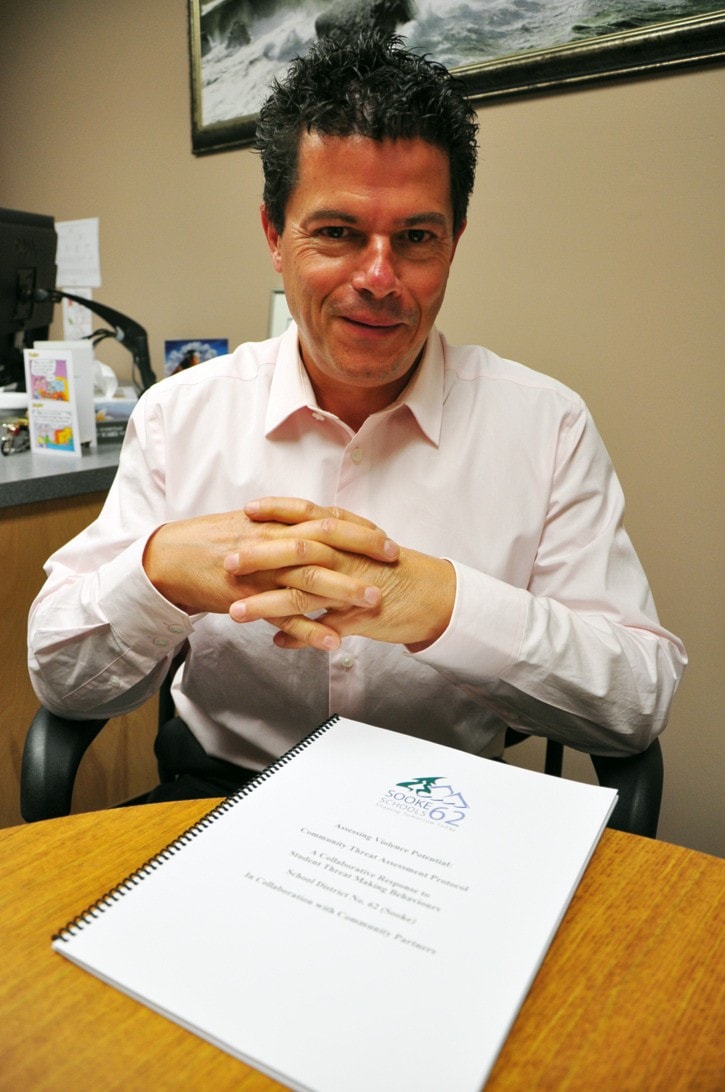The Sooke School District has revamped how it reacts to threats of violence by students in the wake of a number of high-profile criminal incidents within the past two years.
SD 62 signed off on a community threat assessment protocol in June, which establishes close co-ordination with police and government agencies if a student is deemed to be displaying high-risk, threatening or self-destructive behaviour.
Under certain conditions, protocol allows the district and agencies – Ministry of Child and Family Development, the RCMP and the Vancouver Island Health Authority – to share normally private information to help determine the scope and validity of a threat.
“Basically safety trumps privacy, (the protocol) allows agencies to share information,” said Dave Betts, SD 62 assistant superintendent and a key player behind creating the protocol. “We have new rules of engagement. We do have the right to search backpacks and lockers, and we will if we believe there is a safety concern.”
The drive to create a formal risk assessment plan developed after Belmont and Edward Milne high schools suffered bomb threats, a student torched a classroom at Dunsmuir middle school last year. The brutal murder of Kimberly Proctor by students Kruse Wellwood and Cameron Moffat also underlined the need for a more sophisticated threat assessment procedures.
“Usually it’s stuff you would only see on TV, but it’s not TV – it’s happened here,” Betts said. “It’s eye-opening the things that happen in our community. As a result we wanted to look how to ensure safety at the schools.”
The protocol provides systematic, detailed procedures to guide teachers or administrators who see or receive information about a student threat. If deemed a credible risk of violence, a district response team can be called in, who might contact police, social workers or parents to build a broader picture of the student.
Instances where the protocol could be activated include verbal, written or electronic threats of violence against student or staff, bomb threats and bringing weapons to school. Teachers may also recognize changes in student behaviour due to stresses at home or school, and could act to head off acting out in a self-destructive way.
“(Response) really depends on circumstance – if the threat is immediate or brewing in the future. Every event is different, but (the protocol) allows us to figure out the level of risk,” Betts said. “But if a school can’t answer a question, the district team, MCFD, VIHA or police might have the information.”
The district activated response teams several times last year, but Betts declined to reveal details. He said the perceived threats were serious enough to warrant risk assessments.
He stressed the protocol isn’t about arresting or punishing students, but trying to get troubled students help through counselling and fostering a collaborative approach with police and social service agencies.
“Committing a violent act is an evolutionary process, a build up that is predictable. You’ve got to look for indicators,” Betts said. “We have to recognize the indicators and prevent the violent act.”
Betts said having the RCMP, VIHA and MCFD sign off on the protocol was months of negotiations to build a secure system to pass sensitive information within the group, while ensuring it can’t fall into the wrong hands.
“The collaborative group is a powerful component of this,” Betts said. “There is a lot of information sharing.”
Former West Shore RCMP detachment commander Mark Fisher, who signed off on the protocol, said officers regularly deal with troubled youth in isolation from social services or schools.
“This will help put the pieces together so everyone has a clear picture of what’s going on, and can have better responses. We don’t want to interfere if MCFD or the school district is doing something,” Fisher said.
“I think it is a postive step on the part of the school district. It makes sure the right questions are asked when it comes to high risk behaviour and makes all the appropriate people in the know.”
editor@goldstreamgazette.com
